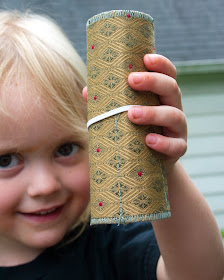It goes in phases, too. For a while I was in a felted wool mood, or a vintage button mood, or a comic book mood. Right now, though, I am absolutely in an upholstery sample mood. It's the perfect sturdy fabric, with enough body to stand up to a ton of projects from birthday crowns to scrapbooking. Lately I've been making crayon rolls with the smaller upholstery samples I've got.
 They're less fussy to make than my rainbow patchwork crayon rolls, but I think that the upholstery fabric, which comes in colors and patterns that you wouldn't normally associate with a children's item, makes for a sophisticated and unusual look, especially since I'm not in love with typical kiddie-type fabrics. And yet I think that the intricate color combinations and detailed patterns and rich feel actually make these still really kid-friendly--it's like my perennial search for kids' music that doesn't also annoy me (Wee Sing is the stuff of my nightmares, but the girls looooove it).
They're less fussy to make than my rainbow patchwork crayon rolls, but I think that the upholstery fabric, which comes in colors and patterns that you wouldn't normally associate with a children's item, makes for a sophisticated and unusual look, especially since I'm not in love with typical kiddie-type fabrics. And yet I think that the intricate color combinations and detailed patterns and rich feel actually make these still really kid-friendly--it's like my perennial search for kids' music that doesn't also annoy me (Wee Sing is the stuff of my nightmares, but the girls looooove it).Anyway, you could make these with home-dec fabric that you bought from the store, I'm sure, but if you do happen across your own upholstery sample book and snatch it up, the smaller-size samples will already be the perfect size for this.
You will need:
- home-dec weight fabric, approximately 4.75"x11" (it isn't hard to change the math, though, if you want to use a different size, perhaps to make a marker or colored pencil roll instead of a crayon roll)
- complementary fabric for the inside and lining, the same length as your home-dec fabric but twice as wide (approximately 9.5"x11")
- sewing machine with heavy-weight needle inserted and matching thread
- approximately 6" of 1/8" elastic
1. Using a satin stitch (or a zig-zag stitch whose length is close to 0)--  --stitch across the two 11" sides of your complementary fabric. This will finish the raw edges, and it gives a nice border to your fabric.
--stitch across the two 11" sides of your complementary fabric. This will finish the raw edges, and it gives a nice border to your fabric.
2. Lay your home-dec fabric face-down on a gridded cutting mat and lay the complementary fabric on top of it. Both fabrics should line up along the 11" length. For the width, however, the complementary fabric should stick out 2" farther than the home-dec fabric on one side (this will be the top, if you want a pattern to face a certain way), and the rest of the extra width will stick out from the other side.
3. Fold both sides of the longer complementary fabric so that the folded edge is even with the raw edge of the home-dec fabric (you can iron this crease or just finger-press it), and pin it into place.
4. Satin stitch around all four sides. This will close any remaining raw edges, and give you two pockets running the entire length of the fabric, a 2" wide one at the top and a wider one at the bottom.
5. Lay your crayon roll back on your gridded mat with the complementary fabric facing up and the 2" wide pocket at the top of the roll. Across the wider pocket, from seam to seam, mark a straight line with a pencil from the top of the pocket to the bottom every 1.25". 
6. Sew over these pencilled lines, locking your stitches at the top and bottom. These are the pockets the crayons will fit into.
7. At either end of the crayon roll, sew your elastic. Fold it in half and use a zig-zag stitch with a length set to 0 to sew the elastic to the crayon roll.
8. Insert crayons and give it to somebody to color with.
I have a few sets of these rolling around the house to throw in a bag when I'm going somewhere with a kid, and I also give them out as birthday and Christmas presents and sell them at craft fairs. 
If you scored your own book of upholstery samples, check out my post on sewing with upholstery samples over at Crafting a Green World.
Great work dear.... keep it up
ReplyDeleteI am not sure if you are still looking for kids music that doesn't drive you crazy, I would suggest Sandra Boynton http://www.sandraboynton.com/sboynton/Introduction.html.
ReplyDeleteWe love them.